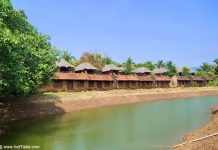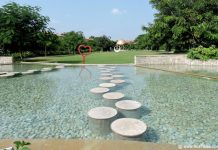Guwahati or Gauhati is not a typical tourist destination. I do not think many people come to this city to see the city except the pilgrims who come to Kamakhya temple. But it is a de facto gateway for coming to North East India Tourism, a commercial hub for the region. And hence intentionally or unintentionally people end up coming here.

Places to visit in Guwahati
Brahmaputra River Front City
Standing on the banks of the mighty Brahmaputra, it may be the only big city in India that has a live river flowing through it. For me, the river itself provides a lot for the visitor to this city. You can just walk on the road that runs parallel to the river, sit back, and observe the life on the banks of the river. People collect water from the river through a makeshift filter, and fishing boats in the middle of the river. Various temples on the bank and river cruises take you for a joyous ride every evening. A bridge on the river in the distance, a temple on a tiny island. Various sand islands when the water is low and sometimes just the silent flow of the river.

For someone who has never lived on the bank of a river, it is very soothing to sit by the river and listen to its silence. As the river on the surface is very silent though I was told that the currents underneath are very powerful. Does it not sound like someone you know, calm on the surface and with a lot of fire in the belly?

Kamakhya Temple, Guwahati
Legend of Kamakhya Temple
Kamakhya temple is probably the best-known ‘to be seen’ spot in Guwahati. Now this temple has both mythological and historical importance. It is one of the Shaktipeethas, and this is where the Yoni of Sati, Shiva’s wife fell when he was carrying her body. Making it the most sacred place for the fertility cult and Tantra. The name Kamakhya literally means the Goddess of Desire. It is also the land of Kamrup, after whom the district is still named. It is believed that the temple originally belonged to the Khasi tribe who used to worship a Goddess called Ka-me-Kha, which became Kamakhya over a period of time.
Kamakhya Temple Visit
I wanted to visit the temple for this and many other reasons. But then I did not want to visit it, as I was not sure if I can handle the gruesome killing of animals. That is offered as a sacrifice to the Goddess, almost every day. I think this is one place where I thought a lot before I finally decided to go. Guess the pull of the Mother Goddess was more than the repulsion of the ways her devotees choose to please her. I was told that the place of sacrifice is away from the main temple and you need not necessarily look at that when you visit. But they did not tell me that all the animals in the line of sacrifice would be roaming around there waiting for their turn.
It is said that when the temple was built, a lot of human sacrifices were offered to the Goddess. There was a community that was only meant to be sacrificed to the Goddess. And these men were fed well and had access to everything that they wanted in the kingdom before they were sacrificed.

Kamakhya Temple – Nilachal Hill, Assam
Located on the Nilachal Hill, the current temple was built in the 16th century by the Koch kings who ruled the region then. Kala Pahar destroyed the earlier temple, and not much is known about it. The hill also has shrines dedicated to all Das Mahavidyas or 10 forms of mother Goddess in the tantric tradition. Temple has an unusual cylindrical-shaped shikhara, with grooves that are probably a part of the Tantric tradition. There are stone-carved images of various Hindu deities around the temple walls that seem to be dated before the last renovation of the temple in the 16th century.
I particularly liked a Lajja Gauri image that for me is a representative image of the place, the Goddess of fertility. If you observe a little closer you will see a lot of mother-child images embedded in various walls of the temple. There is a beautiful small pond called the Saubhagya Kund on the hill that is said to have been built by Indra for the Goddess.
Museum at Kamakhya Temple
A museum is being built behind the temple that will house all the old stuff that was used for the worship of the Goddess. A collection of old doors of the temple not only makes a good view but also shows the evolution of doors in a certain way. There are items used in various ceremonies like utensils and musical instruments. Along with the gifts given by the devotees that can be seen in the museum. The small garden around the museum has a lot of stone sculptures that I assume we’re a part of the temple or its surroundings sometimes.
It would be a good study of the journey of prayer practices of the temple once this museum is complete.
I had a good conversation with the caretaker of the museum, who to begin with said everything happens with the blessings of the Mother Goddess. And eventually, over the conversation says Goddess is what we make of her. In a very unexpected manner, he said if we do not take such good care of the mother, will she be worshiped by so many? She is the mother because we give her that respect and devotion. An eternal question I guess – Who creates whom between God and Man and the answer exists as a dilemma forever.
Umananda Temple on Riverine Island
The Umananda temple is located on the smallest inhabited riverine island in the world, in the middle of Brahmaputra. The island is called Peacock Island and apparently, this name is a contribution of the British. Though the ancient name is Bhasmachal based on the story that Shiva reduced Kamrup to ashes here. The temple is the only thing that this island hillock has. The Ahom kings built the original temple, which was destructed in an earthquake. A local merchant later built the current temple.
You have to take a 5 min ferry from the Umananda Ghat in the main city. And that is the only way you can reach this. They only charge you for going, coming back on any of the boats is free, as anyone who has gone there has to be brought back.

The main temple is a simple one, flanked by some Kamakhya-style small temples around it. A pathway lets you go around the island and admire it from all sides. There are two simple shops, one selling tea, cold drinks, and small snacks. The other selling Prasad. If you take the first ferry in the morning, which is around 10:00 AM. Most of the stuff that you would get on the island will go with you on the boat. It is a very scenic island with the Brahmaputra flowing on all its sides and the hill island standing quietly.
You will see boats of all kinds on the water. We saw a very interesting bamboo bed with a small hut floating on the river, used by the fishermen for fishing. This was the most basic form of a houseboat.

Museums in Guwahati
We saw two museums in the city, one a traditional state museum which has a rich collection of displays. And the other is a new one that tends to showcase the culture of the northeastern state. Through the various artifacts used by people in their day-to-day life and during festivals.
State Museum Guwahati
State Museum has a beautiful gallery of village life in Assam, and as you walk through it, you almost get a feeling of passing through a village. The most notable gallery of this museum is the epigraphic gallery. Where there are stone pillars with inscriptions, and copper plates with land records apart from the regular manuscripts. The numismatics gallery shows small arrows that were used as Naga coins. The metals and terracotta collection is very good with impressive displays.
Srimanta Sankardev Kalakshetra
The new museum is located in the convention center called Sankardev Kalakshetra. This huge venue has several displays in the garden. An entrance gate that is a replica of Rang Ghar in Sibasagar. And a multi-storeyed museum with huge displays in regular galleries. It is a reasonably good place to understand the region and its culture. Other cultural centers around Guwahati are Hajo and Saulkuchi that I could not visit.

Brahmaputra River Cruise
After the devotional and cultural tour of the place, a visit to the state capital will be incomplete without an evening cruise on the Brahmaputra. Goan-style ships with open decks, a dance floor, and a DJ take you for an hour-long excursion on the Brahmaputra. Where from a distance you can see the skyline of the city. And if the clouds permit an excellent view of the sunset. A perfect way to relax in this ancient city and reflect on what you have seen during the day…
Recommend you to read the following travel blog posts for the interesting places to visit in North East India.
Sibasagar – The Temple Town of Assam
Home to Single Horned Rhinos – Kaziranga National Park














Very nice pictures with good write-up
Very nice pictures with good write-up
anuradha I am following your blog from last one month contains beautiful pix and graphic account.
pradeep gupta
hey Anu amazing pixs caught my attn. immediately am sure d text is as intense wh. i’ll surely go thru…..
Nice pictures and a nice post.I am happy as I am from Assam 🙂
Its really nice pics and info about guwahati..